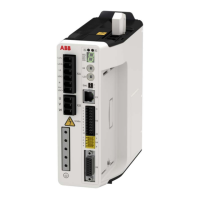Planning the electrical installation 47
Routing the cables
Route the motor cable away from other cable routes. Motor cables of several drives
can be run in parallel installed next to each other. It is recommended that the motor
cable, input power cable and control cables be installed on separate trays. Avoid long
parallel runs of motor cables with other cables in order to decrease electromagnetic
interference caused by the rapid changes in the drive output voltage.
Where control cables must cross power cables make sure they are arranged at an
an
gle as near to 90 degrees as possible. Do not run extra cables through the drive.
The cable trays must have good electrical bondin
g to each other and to the grounding
electrodes. Aluminum tray systems can be used to improve local equalizing of
potential.
A diagram of the cable routing is below.
min 500 mm (20”)
Control cables
min 200 mm (8”)
min 300 mm (12”)
Supply cable
Motor cable
Drive
Braking resistor cable
min 500 mm (20”)
Motor cable
90°
90°
Supply cable
90°
Control cable ducts
240 V24 V24 V 240 V
Lead 24 V and 240 V control cables
in separate ducts inside the cabinet.
Not allowed unless the 24 V cable is
insulated for 240 V or insulated with
an insulation sleeving for 240 V.

